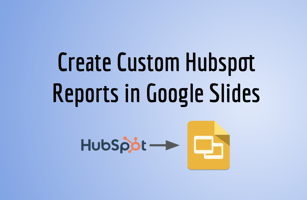HubSpot is a business-critical platform for contact management (CRM), marketing, sales, and...
Export HubSpot Dashboards to Google Docs or MS Word
HubSpot is a business-critical platform for contact management (CRM), marketing, sales, and customer service. The reports and dashboards available in HubSpot make it simple to measure and report on KPIs in all of these business units. In fact, I use them every day! Once you have built reports or dashboards in HubSpot, you may want to insert those charts into presentations and reports. Unfortunately, there was no way to easily export HubSpot charts to Google Docs, Word, or other documents, until Slideform!
Slideform integrates the data you need directly into your custom presentations & reports. This is especially useful for reports that you create on a recurring basis each month or week. Let's see how to use Slideform to put your reporting on auto-pilot!
How to embed HubSpot charts into Google Docs or Word
Slideform uses automation to map your HubSpot charts directly to your pre-formatted report. You can embed multiple charts and combine HubSpot with other data sources as well. For a weekly or monthly report, you can generate a new report with updated data on a schedule.
-
Connect your HubSpot dashboard
Slideform uses the HubSpot dashboard emails to capture the charts from your dashboard for use in reports and presentations.
In Slideform, go to Data Sources > Add Data Source and click Add Integration under HubSpot. You will need to set up dashboard emails in HubSpot and then auto-forward those emails to the Slideform system.
Once the data is connected, you can view, rename, and manage all your charts in Slideform. -
Link your report template
Create a template for your report in Google Docs or Word. The template is a repeatable report with placeholders where you want to insert the charts or other content. The template specifies the text, fonts, colors, and layout that you want in each version of the presentation. This is an example template.
Each placeholder, enclosed in curly braces, in the template will be filled with content from one of your linked Data Sources, including HubSpot dashboards. Read more about the template here: How to create a report template
Upload your Word template in the New Project menu in Slideform, or Authorize your Google account to access your Google Docs and select the correct document. -
Send data to the report
The final step is to match the correct content from HubSpot to each placeholder in your template.
Go to the Data Sources page and click Configure. Then, in the Charts section, select the worksheet (name of your dashboard) and click Preview. This will display each of the charts available for embedding.

You can rename the charts, click the star to "favorite", and send the chart to the slides from this page. To send a chart to your project, click the airplane "send" icon. For more information about data mapping, see: How to Configure the Data Mapping -
Generate reports automatically on a schedule
You can generate a report with updated data any time you want by clicking the Generate button. Or set a schedule and have the slides emailed to you or another recipient.
Here's the output for my template. You can save the report in a variety of formats, including Word, Google Docs or PDF.
To export the charts to PowerPoint or Google Slides, just create your template in that format. Step through an example here.
Slideform puts your reporting on auto-pilot!
- No screenshots! And no copying & pasting.
- Set recurring presentations to auto-generate on a schedule!
- Slides are viewable by all recipients; no HubSpot access required.
- Data (charts, graphs, tables) automatically update when you generate a presentation.
- Combine HubSpot with other data sources and content including spreadsheets, images, and text.
- Use your own custom slide template in the format of your choice.
Did you know? Slideform can also embed HubSpot CRM data (metrics, numbers, text) into your reports. Check it out here.
Start your free Slideform trial today!




